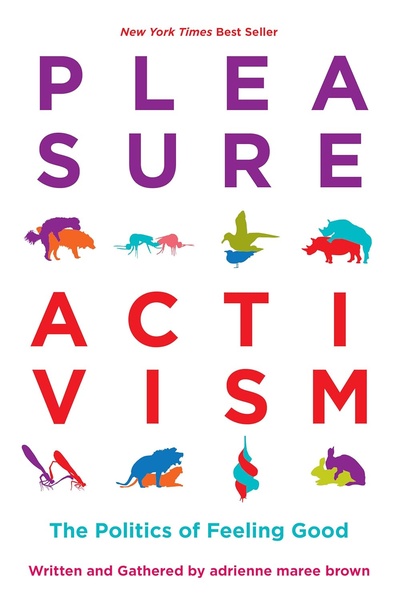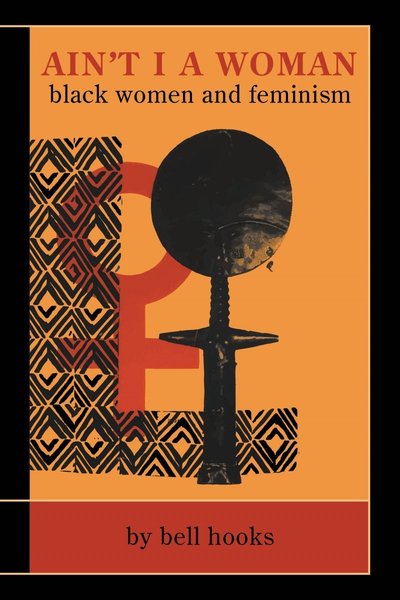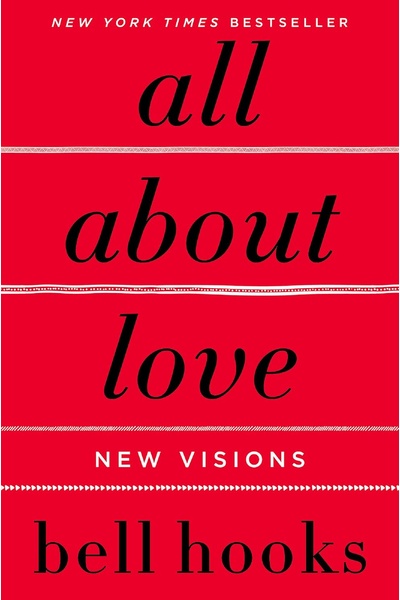Pleasure Activism
Explores how pleasure and joy can become central to social justice work, advocating for liberation politics based on body wisdom and collective delight.

📝 Book Review
“Pleasure Activism” is adrienne maree brown’s revolutionary work that boldly places pleasure at the center of social transformation, fundamentally challenging long-held traditions that equate social movements with suffering and sacrifice. With her keen insights and profound philosophical thinking, brown presents a completely new model of resistance and social change—one that not only acknowledges the political value of joy and pleasure but views them as necessary foundations for building a better world.
When exploring the political significance of pleasure, brown proposes a deeply subversive viewpoint: in a society filled with oppression and injustice, seeking pleasure itself becomes a profound act of resistance. She argues that when a social system systematically deprives certain groups of joy and dignity, these groups’ pursuit of pleasure becomes the most direct and powerful challenge to that system. brown particularly emphasizes the importance of refusing suffering narratives, pointing out that while acknowledging pain and trauma is necessary, romanticizing suffering or viewing it as the only legitimate form of resistance actually perpetuates oppressor logic.
Instead, she advocates for celebrating Black joy, affirming queer desire, and viewing radical self-love as political action. This perspective not only provides marginalized groups with new sources of power but also infuses the entire social justice movement with new vitality and hope.
Body Wisdom and Embodied Knowledge
In exploring body wisdom, brown profoundly excavates the revolutionary significance of bodily sensations as sources of knowledge and guidance. She believes that in a society that has long devalued and controlled bodily experience, relearning to listen to body signals, trust intuitive judgment, follow pleasure’s guidance, and respect bodily boundaries is not only a process of personal healing but a fundamental challenge to dominant knowledge systems.
brown’s analysis reveals the profound opposition between body wisdom and traditional rationalist cognitive models. She argues that bodily knowledge is often more direct and accurate, helping us identify and respond to various environmental information. This emphasis on body wisdom not only provides individuals with more complete cognitive tools but also offers new possibilities for collective decision-making and social organization.
The concept of body wisdom challenges Western philosophy’s mind-body dualism, instead proposing an integrated approach to knowledge that honors both intellectual understanding and embodied experience. This perspective has particular significance for marginalized communities whose ways of knowing have been systematically devalued by dominant academic and cultural institutions.
brown’s approach to body wisdom also connects to broader themes of decolonization, as she draws on traditions that have always understood the body as a source of wisdom rather than obstacle to knowledge. This reclaiming of bodily intelligence becomes a form of cultural and political resistance against systems that seek to control and regulate bodies.
Sexual Liberation and Sexual Justice
In the dimension of sexual liberation, brown demonstrates her profound understanding of sexual autonomy and sexual justice. She advocates for complete sexual autonomy and freedom of sexual expression, viewing them as important components of basic human rights. In her framework, establishing consent culture, celebrating sexual diversity, deconstructing shame complexes, and advancing the decolonization of desire are all core tasks of sexual liberation.
brown particularly emphasizes the concept of sexual justice, organically connecting sexual rights with broader social justice issues, including reproductive justice, transgender rights, sex worker rights, and adolescent sexual education. This holistic perspective not only enriches our understanding of sexual liberation but also provides important theoretical support for building a more inclusive and equal society.
Her approach to sexual justice recognizes that sexual oppression intersects with other forms of oppression based on race, class, gender identity, and other factors. This intersectional understanding leads to more nuanced and effective strategies for creating sexual freedom for all people rather than just privileged groups.
brown also addresses how sexual shame and repression serve broader systems of control, arguing that liberating sexual expression is inseparable from other liberation struggles. Her work contributes to ongoing conversations about how personal liberation and political liberation are interconnected rather than separate projects.
Collective Pleasure and Community Building
The concept of collective pleasure is another important innovation in brown’s theoretical system. She deeply explores the transformative potential of collective joy, believing that practices like collectively creating happiness, cultural celebrations, the liberatory power of music and dance, and collective healing rituals all hold profound political significance.
brown points out that collective pleasure not only enhances community cohesion and identity but can also create new models of social relationships and cultural practices. In terms of relational pleasure, she reimagines possibilities for pleasure-based interpersonal relationships, including non-hierarchical intimate relationships, polyamorous practices, the radical potential of friendship, and the creation of chosen families.
These innovative relationship models not only challenge traditional social norms but also provide people with more diverse and free life choices. The emphasis on collective pleasure counters individualistic approaches to happiness that can become self-centered, instead proposing that individual and collective liberation are intertwined.
brown’s vision of collective pleasure also includes the creation of new cultural forms and practices that center joy and celebration rather than struggle and suffering. This doesn’t mean ignoring real problems but rather insisting that the solutions we create should embody the values and experiences we ultimately want to live by.
Sustainable Activism and Movement Health
brown’s thinking about sustainable activism reflects her deep concern for the long-term healthy development of social movements. She keenly observes the burnout problems many social movements face and proposes pleasure-centered sustainable organizational models. In her theoretical framework, rest is reconceptualized as an act of resistance, play is viewed as a necessary element for maintaining movement vitality, and the cultivation of creativity and the importance of balance are elevated to unprecedented heights.
brown also particularly focuses on the concept of healing justice, advocating for integrating individual and collective healing into all aspects of social movements, including establishing trauma-informed organizational structures, prioritizing physical and mental health, practicing healing circles, and addressing intergenerational trauma. This comprehensive healing orientation not only contributes to the personal growth of movement participants but also enhances the resilience and sustainability of the entire movement.
The sustainable activism model brown proposes challenges the martyr complex that has historically characterized many social movements, instead insisting that activists deserve pleasure, rest, and joy as much as anyone else. This approach recognizes that movements led by people who are thriving are more likely to succeed than movements led by people who are burning out.
Her work also addresses how systems of oppression deliberately create conditions that make sustainable activism difficult, and how pleasure activism can serve as both resistance to these conditions and a model for the kind of world movements are working to create.
Creative Practice and Artistic Expression
In the realm of creative practice, brown deeply explores the central role of creative expression in liberation processes. She believes art is not only an important source of pleasure but holds profound political significance. In her analysis, imagination is viewed as a political force, the pursuit of beauty is understood as radical action, and the collective nature of creative activities is emphasized as an important mechanism for social transformation.
brown’s perspective not only enriches our understanding of art and creativity but also provides new forms of expression and mobilization strategies for social movements. She demonstrates how creative practices can serve multiple functions: personal healing, community building, cultural preservation, and social critique.
The emphasis on creativity also connects to brown’s understanding of how oppressive systems seek to limit imagination and possibility. By insisting on the importance of creative expression, pleasure activism becomes a way of expanding what people can envision for themselves and their communities.
Her approach to creativity is also deeply democratic, rejecting hierarchies that divide people into “artists” and “non-artists” and instead insisting that everyone has creative capacity that can contribute to collective liberation.
Ecological Pleasure and Environmental Justice
brown innovatively proposes the concept of ecological pleasure, organically connecting environmental justice with pleasure politics. She explores pleasurable experiences in natural environments, emphasizes the sensual appeal of land, advocates for sustainable enjoyment methods, and even boldly proposes the concept of ecological eroticism.
This unique perspective not only infuses environmental protection movements with new theoretical resources but also provides an inspiring framework for rethinking human-nature relationships. The concept of ecological pleasure challenges the false separation between human pleasure and environmental health, instead proposing that they are mutually reinforcing.
brown’s ecological approach also addresses how environmental degradation disproportionately affects marginalized communities, connecting environmental justice with pleasure activism through the understanding that everyone deserves access to the pleasure and beauty of healthy environments.
This framework offers alternatives to environmentalist approaches that rely primarily on guilt, fear, or shame to motivate action, instead proposing that love of beauty and pleasure in natural settings can become powerful motivators for environmental protection.
Practical Tools and Implementation
At the practical level, brown provides readers with a series of concrete tools and methods, including pleasure journaling, body scanning exercises, boundary setting techniques, and pleasure mapping. These tools are not only highly operational but more importantly embody the principle of combining theory with practice, providing practical guidance for individual and collective liberation practices.
The tools brown provides are designed to be accessible and adaptable to different contexts and communities. They reflect her understanding that theory must be connected to lived experience and daily practice to create meaningful change.
Many of these practices can be implemented individually as forms of self-care and personal development, while others are designed for group settings and community building. This dual focus reflects brown’s understanding that individual and collective liberation are interconnected processes.
The practical emphasis in brown’s work also demonstrates her commitment to making pleasure activism accessible to people regardless of their academic background or theoretical training, emphasizing that everyone can participate in and contribute to liberation movements.
Healing Justice and Trauma Recovery
A crucial aspect of pleasure activism involves healing justice—the integration of healing practices into social justice work. brown argues that addressing individual and collective trauma is essential for sustainable social change and that pleasure can be both a tool for healing and evidence of progress toward liberation.
Her approach to healing justice recognizes that marginalized communities carry both historical and ongoing trauma from oppression, and that effective social movements must create space for addressing these wounds while also cultivating resilience and joy. This means developing trauma-informed practices that can hold both the reality of harm and the possibility of healing.
brown’s work on healing justice also challenges individualistic approaches to mental health, instead proposing community-based models that understand healing as both personal and political work. This approach recognizes that many mental health challenges stem from oppressive social conditions rather than individual pathology.
The integration of healing and activism also prevents the reproduction of oppressive dynamics within social movements themselves, creating more sustainable and effective approaches to social change.
Intersectional Applications and Global Relevance
While rooted in brown’s experiences as a Black queer woman in the United States, pleasure activism has found relevance across different communities and contexts globally. The framework’s emphasis on honoring diverse forms of knowledge, celebrating cultural practices, and centering the wisdom of marginalized communities makes it adaptable to various cultural contexts.
International applications of pleasure activism have included its use in Indigenous rights movements, LGBTQ+ organizing in different cultural contexts, and environmental justice work worldwide. The flexibility of the framework allows it to be adapted while maintaining its core commitments to justice and joy.
brown’s intersectional approach also ensures that pleasure activism addresses the specific needs and experiences of different marginalized communities rather than imposing a one-size-fits-all model of liberation.
Critiques and Limitations
Some critics have questioned whether pleasure activism adequately addresses systemic inequalities and structural oppression, arguing that its focus on individual and community well-being may not be sufficient for creating large-scale political change. Others have raised concerns about the potential for pleasure activism to be co-opted by capitalist wellness culture.
brown and other practitioners have responded to these critiques by emphasizing that pleasure activism is not a replacement for other forms of political action but rather a complement to them. The goal is not to avoid difficult political work but to ensure that this work is sustainable and connected to the values and experiences that movements are fighting to protect.
The framework also includes explicit critiques of how pleasure and wellness are commodified under capitalism, working to distinguish between pleasure activism and consumer culture approaches to happiness and well-being.
Future Directions and Ongoing Development
Pleasure activism continues to evolve as communities around the world adapt and develop the framework for their own contexts and needs. This ongoing development reflects brown’s understanding that effective frameworks for liberation must be dynamic and responsive to changing conditions and community wisdom.
Current applications and developments include integration with disability justice work, expansion into organizational development and workplace culture, and connections with indigenous healing traditions and practices. These developments demonstrate the continued relevance and adaptability of pleasure activism principles.
The framework’s emphasis on experimentation and adaptation also means that its future development will likely continue to emerge from grassroots organizing and community practice rather than academic theorizing alone.
Conclusion: Redefining the Possibilities of Social Change
“Pleasure Activism” redefines the possibilities of social transformation. The most profound contribution of this work lies in reminding us that the world we fight for should be a world we begin to experience and create now. Through her theoretical innovations and practical wisdom, brown shows us a completely new path to liberation—one built not on sacrifice and suffering but on joy, creativity, and collective flourishing.
brown’s work challenges activists and organizers to consider how their methods and practices align with their values and goals. If we are working toward a world characterized by justice, freedom, and joy, then our movements themselves should embody these qualities rather than reproducing the oppressive dynamics they seek to change.
The lasting significance of pleasure activism lies in its insistence that liberation is not just about ending oppression but about creating conditions for all people to thrive. This vision requires not only dismantling harmful systems but also cultivating the relationships, practices, and cultures that will sustain more just and joyful ways of living.
Through pleasure activism, brown offers both a critique of current conditions and a vision of alternatives, demonstrating that effective social change requires both clear analysis of problems and creative imagination about solutions. Her work continues to inspire movements worldwide to center pleasure, healing, and joy as essential elements of justice work, creating more sustainable and transformative approaches to social change.
Discussion
读书讨论
分享您对这本书的感想和看法,与其他读者交流见解
加入讨论
分享您对这本书的感想和看法,与其他读者交流见解
加载评论中...
Book Info
🛒 Get This Book
 Buy on Amazon
Buy on Amazon Related Books
读书讨论
分享您对这本书的感想和看法,与其他读者交流见解
加入讨论
分享您对这本书的感想和看法,与其他读者交流见解
加载评论中...

